
Boiled peanuts are popular in some places where peanuts are common. Fully mature peanuts do not make good quality boiled peanuts; rather, raw or green ones are used. Raw denotes peanuts in a semi-mature state, having achieved full size but not being fully dried, as would be needed for roasting or peanut butter use. Green denotes freshly harvested and undried peanuts that must be refrigerated. After boiling in salt water they take on a strong salty taste, becoming softer with prolonged cooking, and somewhat resembling a pea or bean, to which they are related because they are legumes and a nut only in the culinary sense.
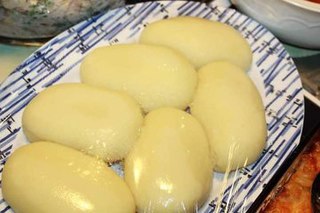
Fufu is a pounded meal found in West African cuisine. It is a Twi word that originates from the Akans in Ghana. The word has been expanded to include several variations of the pounded meal found in other African countries including Sierra Leone, Guinea, Liberia, Cote D'Ivoire, Burkina Faso, Benin, Togo, Nigeria, Cameroon, the Democratic Republic of Congo, the Central African Republic, the Republic of Congo, Angola, and Gabon.

Ẹ̀bà (Yoruba) also known as Ebe or Pinon' is a staple swallow from Togo and Benin, also eaten in the West African sub-region and other African countries. The term èbà originates from Yoruba. It is also called utara by the Igbo people of southeast Nigeria. It is a cooked starchy vegetable food made from dried grated cassava (manioc) flour commonly known as garri all across West Africa. It is often eaten with rich soups and stews, with beef, stockfish or mutton. The dish is often described as having a slightly sour, sharp taste.

Ugali, also known as posho, nsima, and other names, is a type of corn meal made from maize or corn flour in several countries in Africa. It is cooked in boiling water or milk until it reaches a stiff or firm dough-like consistency. In 2017, the dish was added to the UNESCO Representative List of the Intangible Cultural Heritage of Humanity, one of a few foods in the list.

Egusi also known as agusi, ohue, Ikpan, Ikon, agushi or mbíka) is the name for the protein-rich seeds of certain cucurbitaceous plants, which, after being dried and ground, are used as a major ingredient in West African cuisine.

Àmàlà is a staple swallow food popularized by the Yoruba ethnic group of Southwestern Nigeria and other parts of Yorubaland. It is made of yam, cassava flour, or unripe plantain flour. Tubers of yams are peeled, sliced, cleaned, dried and then ground into flour. It is also called èlùbọ́. Yams are white in colour but turn brown when dried which gives àmàlà its colour. It is a popular side dish served with ewédú and gbẹ̀gìrì, but is also served with a variety of other ọbè(soups), such as ẹ̀fọ́, ilá, and ogbono.

Ghanaian cuisines refer to the meals of the Ghanaian people. The main dishes of Ghana are organized around starchy staple foods, accompanied by either sauce or soup as well as a source of protein. The main ingredients for the vast majority of soups and stews are tomatoes, hot peppers, and onions. Most Ghanaian soups and stews are red or orange in appearance as a result of the main ingredients used.

Peanut stew or groundnut stew, also known as maafe, sauce d'arachide (French) or tigadèguèna is a stew that is a staple food in Western Africa. It originates from the Mandinka and Bambara people of Mali.

West African cuisine encompasses a diverse range of foods that are split between its 16 countries. In West Africa, many families grow and raise their own food, and within each there is a division of labor. Indigenous foods consist of a number of plant species and animals, and are important to those whose lifestyle depends on farming and hunting.

Nigerian cuisine consists of dishes or food items from the hundreds of Native African ethnic groups that comprise Nigeria. Like other West African cuisines, it uses spices and herbs with palm or groundnut oil to create deeply flavored sauces and soups.
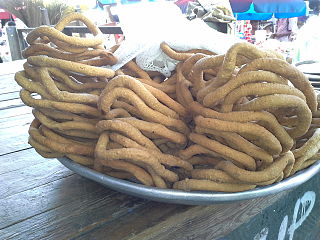
Kuli-kuli is a West African snack primarily made from peanuts, first made by the various ethnic groups including the Nupe people of Nigeria and Dagbon people of Ghana. It is a popular snack in Nigeria, Benin, northern Cameroon and Ghana. It is often eaten alone or with a mixture of garri also known as cassava flakes, sugar and water, popularly called "garri soakings". It is also eaten with Hausa koko, fura, and kamu, and is sometimes ground and put into salad. It is often ground and used as an ingredient for suya and kilishi.

Togolese cuisine is the cuisine of the Togolese Republic, a country in Western Africa. Staple foods in Togolese cuisine include maize, rice, millet, cassava, yam, plantain and beans. Maize is the most commonly consumed food in the Togolese Republic. Fish is a significant source of protein. People in Togo tend to eat at home, but there are also restaurants and food stalls.
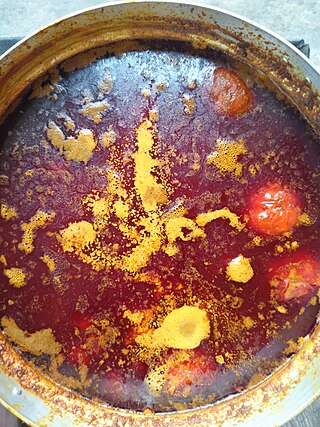
Palm nut soup or banga is a soup made from palm fruit common in the Cameroonian, Ghanaian, Nigerian, Democratic Republic of Congo and Ivorian communities. The soup is made from a palm cream or palm nut base with stewed marinated meats, smoked dried fish, and aromatics. It is often eaten with starch, fufu, omotuo, banku, fonio, or rice. The use of the palm fruit in cooking is significant in Ivorian, Cameronian, Nigerian, Ghanaian, Liberian and other West and Central African cuisine.
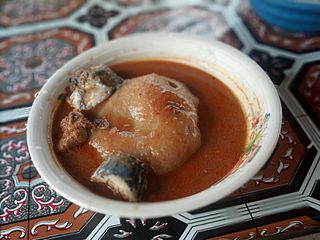
Kokonte, also known as abeti3, lapiiwa, lapelawa or “face the wall”, is a staple swallow food eaten in some parts of Africa including Togo, Ghana and others. In Ghana, kokonte is eaten by most of the ethnic groups like the Ga, Akan, Hausa, Kokonte usually is brown, grey and deep green depending on the type of ethnic group that prepares the dish. Kokonte is usually prepared out of dried cassava or yam.
Plakali is a staple food mainly prepared by the Ahanta and Nzema peoples of the Western region of Ghana and Côte d’Ivoire. It consists of cassava dough cooked in hot water, and it is similar to banku, another Ivorian and Ghanaian staple food, and fufu. Plakali is eaten with palm nut or groundnut soup.
Hausa cuisines are traditional and modern food prepared by Hausa people. It is based on the availability of raw food materials they can farm or provide from other places. Most times Hausa people depend purely on the farm products they have cultivated for food preparations. Hausa people have a meal that is common to most Zongo communities called Tuo Zaafi.
The Chop Bar is a Ghanaian food centre that serves local cuisines in a contemporary dining setting. It was founded by Elias Hage and Mona Quartey El Halabi in 2015
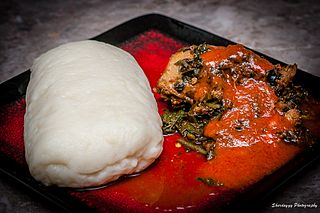
Pounded yam or Iyán (Yoruba) or Ruam-Yo (Tiv) is a Nigerian swallow food native to the Yoruba, Igbo, Tiv and Ebira ethnic groups. It is a traditional food. It is prepared by pounding boiled yam with a mortar and pestle. Pounded yam is similar to mashed potatoes but heavier. It is a smooth and tasty delicacy traditionally eaten with the hands.
Eka soup, also known as ekuku, is a delicacy of three tribes in the Eastern region of Nigeria. It is prepared from mashed palm kernel, roasted groundnut and benne seeds. Eka soup is commonly eaten with starchy foods such as fufu. Eka Soup is a popular dish among the Idomas of Benue State, the Ogojas in Cross River and the Ibirams of Kogi state.
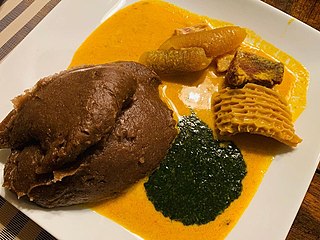
Edo traditional food consists of dishes or food items common among the people of Edo State. The State is home to various ethnic groups including the Binis, Ishan (Esan), Afemai, Etsako, Uzebba Iuleha people [Owan] and others. The Traditional food found among these people usually involves soup and swallow. 'swallow' is a term for Nigerian meals that are taken with soup and ingested without chewing.



















